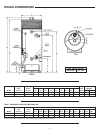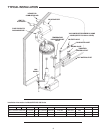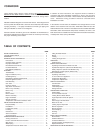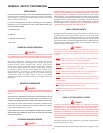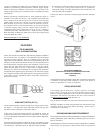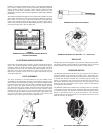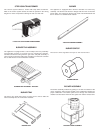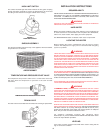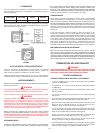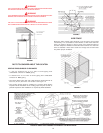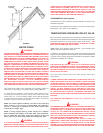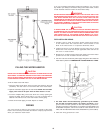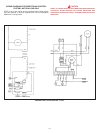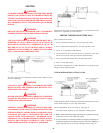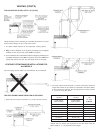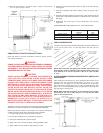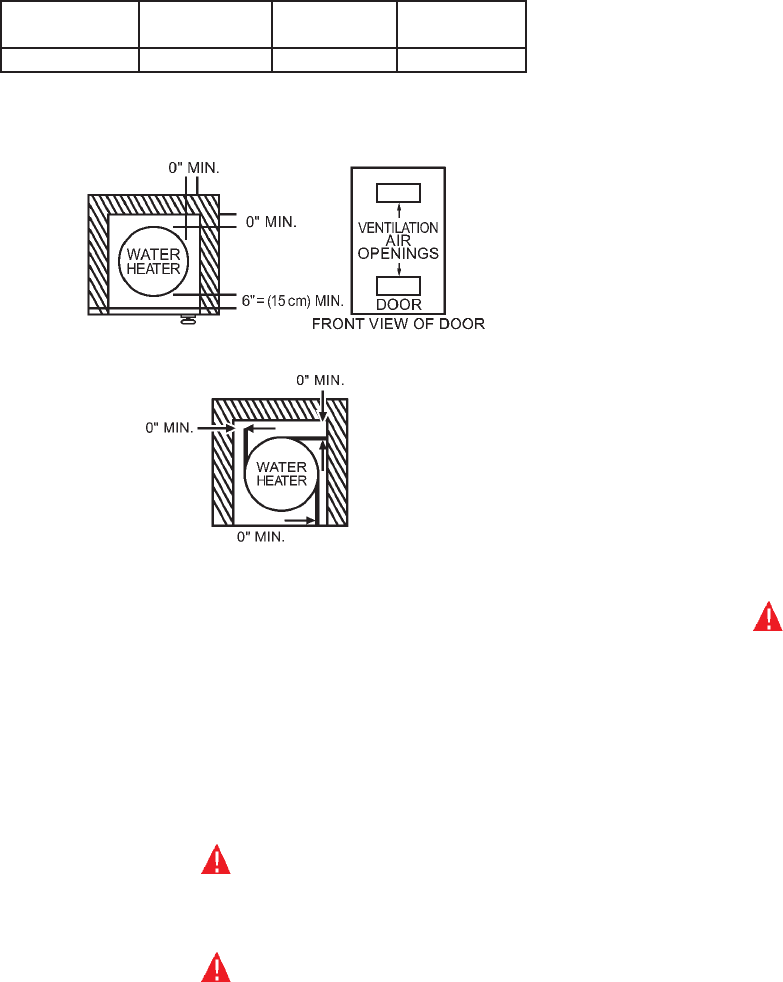
10
CLEARANCES
The unit is approved for installation on combustible flooring in an alcove
when the minimum clearance to combustibles is maintained per Figure 6
and the table below.
ABCD
(RIGHT SIDE) (LEFT SIDE) (BACK) (CEILING)
0" (0cm) 0" (0cm) 0" (0cm) 12" (30.5 cm)
A service clearance of 24" (61 cm) should be maintained from serviceable
parts, such as relief valves, flue baffles, flue damper devices, thermostats,
cleanout openings or drain valves.
FIGURE 5
FIGURE 6
ALCOVE INSTALLATION (ACCEPTABLE)
An alcove suitable for the installation of a water heater is a restricted
section of a room not separated from the room by a door or partition and
which meets the minimum clearances for the water heater.
*When the ceiling height exceeds 8 feet (2.4 m), you are only allowed to
consider 8 feet (2.4 m) when calculating the total volume of the enclosure.
AIR REQUIREMENTS
REFER TO THE CURRENT EDITION OF THE NATIONAL FUEL GAS CODE
ANSI Z223.1/NFPA 54.
WARNING
KEEP APPLIANCE AREA CLEAR AND FREE OF COMBUSTIBLE MATERIALS,
GASOLINE AND OTHER FLAMMABLES, VAPORS AND LIQUIDS.
DO NOT OBSTRUCT THE FLOW OF COMBUSTION OR VENTILATING AIR.
WARNING
FOR SAFE OPERATION PROVIDE ADEQUATE AIR FOR COMBUSTION AND
VENTILATION. AN INSUFFICIENT SUPPLY OF AIR WILL CAUSE
RECIRCULATION OF COMBUSTION PRODUCTS RESULTING IN AIR
CONTAMINATION THAT MAY BE HAZARDOUS TO LIFE. SUCH A CONDITION
OFTEN WILL RESULT IN A YELLOW, LUMINOUS BURNER FLAME, CAUSING
CARBONING OR SOOTING OF THE COMBUSTION CHAMBER, BURNERS
AND FLUE TUBES AND CREATES A RISK OF ASPHYXIATION.
Where an exhaust fan is supplied in the same room with a heater, sufficient
openings for air must be provided in the walls. UNDERSIZED OPENINGS WILL
CAUSE AIR TO BE DRAWN INTO THE ROOM THROUGH THE CHIMNEY, CAUSING
POOR COMBUSTION. SOOTING MAY RESULT IN SERIOUS DAMAGE TO THE
HEATER AND RISK OF FIRE OR EXPLOSION.
UNCONFINED SPACE
In buildings of conventional frame, brick, or stone construction, unconfined spaces
may provide adequate air for combustion, ventilation and draft hood dilution.
If the unconfined space is within a building of tight construction (buildings using
the following construction: weather stripping, heavy insulation, caulking, vapor
barrier, etc.), air for combustion, ventilation and draft hood dilution must be obtained
from outdoors. The installation instructions for confined spaces in tightly constructed
buildings must be followed to ensure adequate air supply.
CONFINED SPACE
When drawing combustion and dilution air from inside a conventionally
constructed building to a confined space, such a space shall be provided
with two permanent openings, ONE IN OR WITHIN 12 INCHES (30.5 cm)
OF THE ENCLOSURE TOP AND ONE IN OR WITHIN 12 INCHES (30.5 cm)
OF THE ENCLOSURE BOTTOM. Each opening shall have a free area of at
least one square inch per 1000 Btuh (2,225mm²/Kw) of the total input of
all appliances in the enclosure, but not less than 100 square inches (645
square cm).
If the confined space is within a building of tight construction, air for
combustion, ventilation, and draft hood dilution must be obtained from
outdoors. When directly communicating with the outdoors or communicating
with the outdoors through vertical ducts, two permanent openings, located
in the above manner, shall be provided. Each opening shall have a free
area of not less than one square inch per 4000 Btuh (8,900mm²/Kw) of the
total input of all appliances in the enclosure. If horizontal ducts are used,
each opening shall have a free area of not less than one square inch per
2000 Btuh (4,450mm²/Kw) of the total input of all appliances in the enclosure.
MECHANICAL EXHAUSTING OF ROOM AIR
Where an exhaust fan is installed in the same room with a heater, sufficient
openings for air must be provided in the walls. UNDERSIZED OPENINGS
WILL CAUSE AIR TO BE DRAWN INTO THE ROOM THROUGH THE HEATER'S
VENTING SYSTEM, CAUSING POOR COMBUSTION AND/OR SOOTING
WHICH MAY RESULT IN SERIOUS DAMAGE TO THE HEATER AND RISK OF
FIRE OR EXPLOSION. IT CAN ALSO CREATE A RISK OF ASPHYXIATION.
COMBUSTION AIR AND EXHAUST
WARNING
WHEN DETERMINING THE INSTALLATION LOCATION FOR A POWER
DIRECT VENT WATER HEATER, SNOW ACCUMULATION AND DRIFTING
SHOULD BE CONSIDERED IN AREAS WHERE APPLICABLE.
VENTING CLEARANCES
VENTING THROUGH AN OUTSIDE WALL-CLEARANCES
• 1" (2.5 cm) clearance for 4" or 6" PVC or CPVC piping from combustible
surfaces for outlet piping.
• 0" clearance for 4" or 6" PVC or CPVC piping from combustible surfaces
for inlet piping.
• 18" (46 cm) minimum in all directions from any obstruction, such as a wall,
that may interfere.
• 18" (46 cm) minimum from the ground and 9" from ceiling overhangs.
See Figure 7.
• The Power Direct Vent outlet terminal shall terminate a least 36" (91 cm)
above any forced air inlet located within 10 feet. See Figure 8.
• The Power Direct Vent outlet terminal shall terminate at least 36" (91 cm)
below, 36" (91 cm) horizontally from or 18" (46 cm) above any door,
window or gravity air inlet into the building. See Figure 8.
• 18" (46 cm) minimum from other natural draft (gravity) direct vent, power
vent or power direct vent appliance inlet and/or outlet vent(s) when directly
above or 135° to either side of center line. See Figure 9.
• 36" (91 cm) minimum from any appliance inlet and / or outlet vents when
directly below or 45° to either side of center line. See Figure 9.
• Vent termination must not be within 4 feet of any items such as gas
meters, gas valves or other gas regulating equipment.
• The venting system must be installed in a manner which allows inspection
of the installation of the venting pipes and joints as well as periodic
inspection after installation as required by ANSI Standards.



